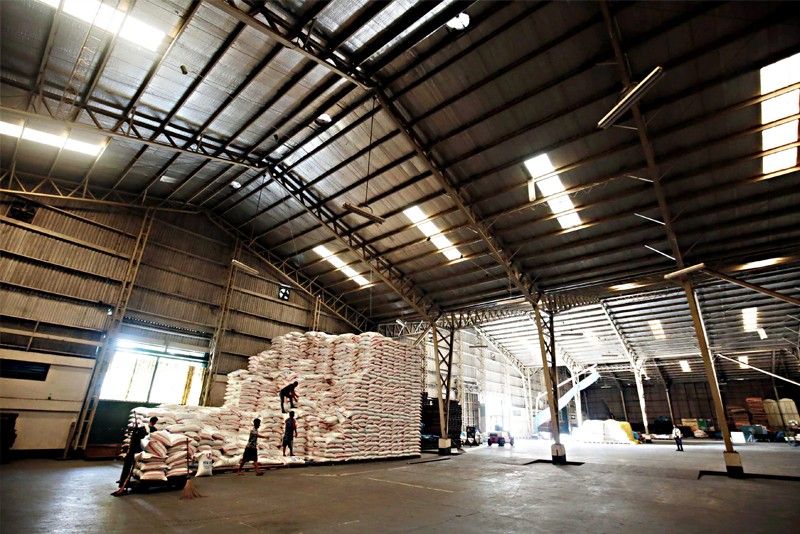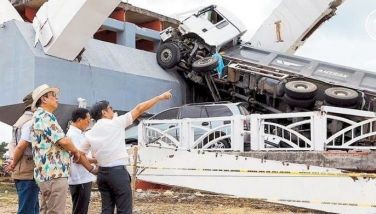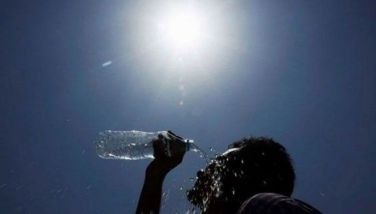Duterte OKs 250,000 metric tons rice imports

Photo shows the remaining rice supply at a National Food Authority warehouse in Quezon City yesterday. Michael Varcas
MANILA, Philippines — President Duterte has approved the importation of 250,000 metric tons of rice in the face of reports that the buffer stock of the National Food Authority (NFA) is fast depleting, an official said yesterday.
Secretary to the Cabinet and NFA Council chairman Leoncio Evasco said he was instructed by Duterte on Wednesday night to activate the standby order to import 250,000 metric tons (MT) of rice.
“Last night, I received an oral order, an instruction from the President to buy the standby rice,” Evasco told ABS-CBN News yesterday.
Evasco said the rice to be imported is on top of the 325,000 MT of the staple to be imported under the minimum access volume (MAV) scheduled to arrive this month.
“We have no option but to follow the President to activate the 250,000 metric tons on standby,” he said.
Evasco explained that the NFA clearance approves the request of the NFA management to buy rice from abroad. He said the approval would be given if the National Food Security Council certifies that there is a need to increase the rice supply in the country.
“We are so careful in buying so as not to affect the production of local farmers,” Evasco said.
In a meeting with former communist rebels in Malacañang last Wednesday, Duterte said Filipinos would go hungry if the government does not import rice.
“If we won’t import from Vietnam, Thailand, Laos, we will be hungry. That’s the problem there,” Duterte said.
Evasco reiterated that the Philippines is not facing a rice supply problem.
In an interview with reporters last Wednesday, Evasco said the NFA Council is cautious about rice imports, saying some groups may be creating “drama” to prod government to import the staple.
“I have to check and call for a meeting of the council to find out what is true or is this just a drama to pressure the council to purchase rice. This is very sensitive, it is about a purchase,” Evasco said.
The NFA imports rice during lean months and not during harvest season to avoid affecting the production of Filipino farmers.
“The request of NFA for 250,000 MT replenishment of our buffer stocks has been approved by the Office of the President,” NFA administrator Jason Aquino said yesterday.
With the authorization to import the 250,000 MT of rice, it will take 45 days before the supplies reach the country.
However, NFA stocks will be fully depleted 35 days from now which means that there might be a 10-day vacuum period where there will be no supply of NFA rice.
Because of this, NFA said it will try to procure more local palay so as not to have a vacuum and still have available supply for calamities and the island provinces in the country.
The confirmation from the grain agency came after presidential spokesperson Harry Roque and Evasco in different briefings yesterday morning issued conflicting statements.
Roque insisted that there is no need to import rice while Evasco was quoted saying that the President late on Wednesday had approved the additional import request by NFA.
Since last year, NFA has been requesting for the importation of 250,000 MT of rice for it to be able to sustain its food security and stabilization mandate but the council refused to give the green light due to the sufficient national inventory.
This, according to NFA, has resulted in the depleting stocks in the market, prompting a spike in the price of commercial rice.
The House of Representatives was urged yesterday to hold an inquiry into the country’s rice supply in view of conflicting statements from Piñol and NFA officials.
Several congressmen made the call, noting that while Agriculture Secretary Manny Piñol has assured the nation that there is not only ample supply but a surplus as well, NFA’s Aquino has claimed there was “lack of harvest” and his spokesperson Rebecca Olarte said NFA stocks were good only for two to three days.
NFA clarified what Evasco earlier said regarding the 325,000 MT of rice under the MAV that has started arriving.
“Yes, additional supply but at what price, we don’t know,” Olarte said.
MAV refers to the volume of a specific agricultural product allowed to enter the country at a lower tariff as a commitment of the Philippines under the General Agreement on Tariffs and Trade of the World Trade Organization.
It was in August 2017 when NFA opened to private traders the importation of up to 805,200 metric tons of rice under the MAV scheme.
Private traders were allowed to import up to 293,100 MT each from Thailand and Vietnam, while the rest would come from other countries. Rice importers can also buy up to 50,000 MT each from China, India and Pakistan, up to 15,000 MT from Australia, 4,000 MT from El Salvador, and 50,000 MT from any country.
On the other hand, Secretary Piñol has recommended that an actual inspection of all rice warehouses in the country be conducted by the proper government agencies.
“The greedy rice cartels are operating again by using the tested and proven scare tactics of a rice shortage to justify the increase of prices in the market and to pressure government into allowing more imported rice to be brought into the country,” Piñol said.
“This is the best counter-attack to the attempt to sow panic among consumers by spreading the fake news that there is a rice shortage. It is also recommended that the proper government agencies should make the rounds of markets to ensure that rice is not priced unreasonably,” he added.
Likewise, NFA is looking at the option of recommending that the Department of Trade and Industry (DTI) put a cap on the price of rice while the current demand and supply for the commodity remain unstable.
While the DTI places and monitors suggested retail price (SRP) of basic commodities, it does not include rice, specifically commercial rice.
Commercial rice prices now range from P41 to P57 per kilo which is unaffordable for many Filipinos.
Local traders warned of a minimum increase of P5 in commercial rice prices following NFA’s low inventory.
Rice probe
House members want an investigation on the rice supply in view of conflicting statements from government officials.
Isabela Rep. Rodolfo Albano lll said conflicting statements are confusing the public and giving unscrupulous traders the opportunity to take advantage of the situation by increasing selling prices to the detriment of consumers.
There has been a noticeable movement in retail prices “even if there is sufficient supply based on the assurance of Secretary Piñol, which I have no reason to doubt since he and his agency are in charge of rice production,” he said.
“Alarmist statements from irresponsible officials are causing panic and more suffering on our people,” he said.
Sen. Cynthia Villar, chairperson of the committee on agriculture and food, is also set to conduct an inquiry into the supply of NFA rice.
According to Villar, there should be no problem with supply especially with the harvest season just around the corner.
Rep. Gary Alejano of Magdalo said a House inquiry would address the concerns of the public.
He said Olarte has admitted that the NFA inventory was good for at most three days, 12 days short of the agency’s required buffer stock of 15 days.
“Many Filipinos purchase the NFA-distributed rice because of its cheaper price. With the inadequate supply in markets now, consumers are forced to buy more expensive rice varieties,” he said.
Rep. Michael Romero of 1-Pacman party-list group, who has filed a resolution seeking an investigation, said the House should find out why the supposed shortage of NFA rice happened.
“We should ascertain whether this is the work of any syndicate within and outside the NFA in an effort to artificially create a supply shortage and price surge,” he said.
Another House member, Orestes Salon of party-list group Agri, said while Olarte declared that NFA stocks were good for up to three days, Aquino claimed they would last for 35 days.
“These conflicting statements were made on the same day. What’s the real score? The allegations by groups such as Bantay Bigas that the NFA is raising a false alarm to justify its request to import rice should be investigated,” he said.
He said importation should be the last option, as
he urged the public to report any increase in the price of rice in their area.
- Latest
- Trending




























